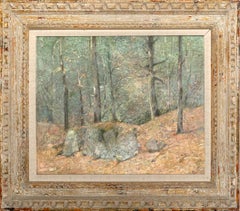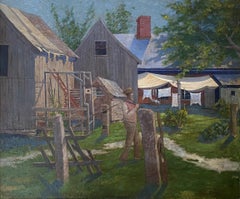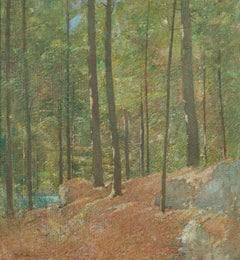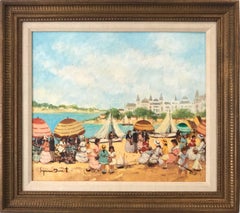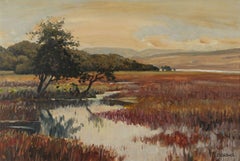Emil Carlsen Art
American, 1853-1932
Regarded today as one of the more prominent artists of the late 19th Century, Emil Carlsen spent many years as a penniless painter on the fringes of the art world, while he continued developing his still-life painting techniques that would take the rest of the art world several decades to fully appreciate.
Born Soren Emil Carlsen in Copenhagen around 1853, Carlsen first began his studies at the Royal Danish Academy as a teenager. Yet he was not to remain long there, leaving in 1872, at nineteen years old for America where he settled in Chicago, working for an illustration house to support himself.
By 1875, he had saved enough money to travel to both Paris and Copenhagen to paint and study, staying for six months before returning to America, this time to New York. By this time he had already developed a unique love affair with the still life. In New York he befriended fellow painters such as John Francis Murphy; yet the city could not contain him, and after only a year he relocated to Boston, where he developed a life-long friendship with Childe Hassam.
Carlsen remained quite poor throughout his time in Boston where he spent the next eight years. Yet his abilities were developing quite rapidly in still life painting, in a style which scholars refer to as "kitchen still lifes." These were still life scenes that often included fish or birds along with pots and pans which gave implied presence of the cook outside the frame, giving them a more human element than most still life subjects. This style very much echoed the work of the Dutch and Spanish Masters of still life, particularly that of Jean Simeon Chardin and, to a lesser degree, Johannes Vermeer. The similarity is not coincidental, as Carlsen spoke and wrote often of the influence of these artists on his own work, and yet he was already beginning to develop the eye for color, light and composition that today we regard as the undeniable Carlsen style.
It was not until the 1910's and 20's that Carlsen began to really benefit financially from his painting, even though he'd already had the respect of his fellow artists all along. Despite his long career and his wide travels, he left few written accounts of his travels, and thus there are many in his biography that historians have tried to reconstruct. He often abandoned certain traits only to pick them up again before finally discarding them as he honed his style and his eye. The result is evidence of an artistic meditation that progressed with consistency and caution.
Carlsen's death in 1932 was at the height of his popularity, and he left behind an admirable body of work in which he had redefined the cerebral and metaphysical effects a still life can have on a viewer. to
1
1
1
1
Overall Width
to
Overall Height
to
1
2
1
2
1
2
1
1
1
1
1
1
1
1
1
1
1
1
3
3
2
2
3
8,232
2,807
1,650
1,318
2
3
Artist: Emil Carlsen
Monochromatic Delicate Impressionist Landscape " A Forest Scene"
By Emil Carlsen
Located in Miami, FL
Danish-American artist Søren Emil Carlsen paints a post-impressionist landscape that blurs the line between representation and abstraction. With its open composition, the artist capt...
Category
1910s Post-Impressionist Emil Carlsen Art
Materials
Canvas, Oil
"A Man in His Garden, " Emil Carlsen, Backyard and Barn Impressionist Landscape
By Emil Carlsen
Located in New York, NY
Soren Emil Carlsen (1848 - 1932)
A Man in His Garden, 1893
Oil on canvas
28 3/4 x 35 1/2 inches
Signed and dated lower right
Provenance:
The artist [1848-1932]
Macbeth Gallery, New York
Grand Central Art Galleries, New York
Luella May (Ruby) Carlsen (the artist's wife), New York
Dines Carlsen (the artist's son), Falls Village, Connecticut
Private Collection, Miami, Florida
Exhibited:
New York, Macbeth Gallery, Summer Exhibition: Painting by American Artists, July - August, 1926, no. 31 (as The Man in the Garden).
Houston, Texas, Museum of Fine Arts, Exhibition of Contemporary American Art by Members of the Grand Central Art Galleries, January 13 - 27, 1929 (as The Man in the Garden).
Miami Antique...
Category
1890s American Impressionist Emil Carlsen Art
Materials
Canvas, Oil
$48,000 Sale Price
20% Off
Pine Woods
By Emil Carlsen
Located in New York, NY
Signed lower left: Emil.Carlsen.
Category
20th Century American Impressionist Emil Carlsen Art
Materials
Oil
$28,500
Related Items
"Summer Day at Nice" French Beach Scene Impressionistic Oil Painting on Canvas
By Suzanne Demarest
Located in New York, NY
A stunning oil painting scene depicting figures by the beach in a sunny day at Nice, France done in the 20th Century. The vibrant colors and impressionistic brushwork is done with bo...
Category
Early 20th Century American Impressionist Emil Carlsen Art
Materials
Canvas, Oil
$4,000 Sale Price
20% Off
H 24 in W 27 in D 2 in
Post-Impressionist Oil Painting of Donegal Wetlands Landscape in Ireland
Located in Preston, GB
Post-Impressionist Oil Painting of Donegal Wetlands Landscape in Ireland by 20th Century Irish Artist, Charles McNeill Caldwell. Signed, Ori...
Category
1960s Post-Impressionist Emil Carlsen Art
Materials
Oil, Canvas
$1,413 Sale Price
30% Off
H 16 in W 24 in D 1 in
Early 20th Century Mission San Juan Capistrano - Figurative Landscape
By Warren E. Rollins
Located in Soquel, CA
Stunning figurative landscape of the Mission San Juan Capistrano by Warren Eliphalet Rollins (American, 1861-1962). Presented in a giltwood frame. "Capistrano" lower right, unsigned. This is a study for a larger painting of the same scene. Image size, 14.5"H x 21"W.
For many years Warren Eliphalet Rollins was known as the "Dean of the Santa Fe art colony." He was the first artist to have a formal exhibition there; it was held in 1906 in the old Palace of the Governors. He was a close friend of Carlos Vierra, Gerald Cassidy, Kenneth Chapman, Sheldon Parsons and most of the other famous artists who assembled in the New Mexican capital during the first half of this century.
Born in Carson City, Nevada, Rollins was raised in California and attended the San Francisco School of Design where he studied under Virgil Williams. At the completion of his studies, he was awarded the Avery Gold Medal and made Assistant Director of the school. Following his marriage in 1887, he and his wife settled in San Diego, and it was during this period that Rollins became interested in the Indian as subject matter. In search of material, Rollins, his wife, and their two daughters, Ramona and Ruth, traveled through every Western state from the Mexican to the Canadian borders. While in Montana, Rollins painted a portrait of Calamity Jane...
Category
1910s American Impressionist Emil Carlsen Art
Materials
Canvas, Oil
$4,400 Sale Price
20% Off
H 19 in W 26 in D 2 in
Medieval Castle on a Cliff by the Sea on North Coast of Ireland by Irish Artist
Located in Preston, GB
Medieval Castle on a Cliff by the Sea on North Coast of Ireland by 20th Century Irish Artist, John Wright. An impressionistic impasto original oil painting of Dunce Castle, used in Game of Thrones.
Art measures 24 x 18 inches
Frame measures 34 x 28 inches
This vibrant painting captures the dramatic beauty of a rugged coastal scene, dominated by an ancient castle perched atop a rocky cliff. The artist's dynamic brushwork and bold use of color bring the landscape to life, with the turquoise and blue hues of the sea contrasting against the warm, sunlit rocks and castle walls. The swirling water and textured rocks in the foreground add depth and movement, making the scene both captivating and lively. Encased in a classic gold-trimmed frame, this artwork is a striking piece that will add a touch of historical grandeur and natural beauty to any space.
Dunluce Castle is a now-ruined medieval castle in Northern Ireland, the seat of Clan MacDonnell. It is located on the edge of a basalt outcropping in County Antrim and is accessible via a bridge connecting it to the mainland. The castle is surrounded by extremely steep drops on either side, which may have been an important factor to the early Christians and Vikings who were drawn to this place where an early Irish fort once stood.
Dunluce is one of the most picturesque and romantic of Irish Castles. With evidence of settlement from the first millennium, the present castle ruins date mainly from the 16th and 17th Centuries. It was inhabited by both the feuding McQuillan and MacDonnell clans.
Richard Óg de Burgh, 2nd Earl of Ulster, built the first castle at Dunluce, In the 13th century. The earliest features of the castle are two large drum towers about 9 metres (30 ft) in diameter on the eastern side, both relics of a stronghold built here by the McQuillans after they became lords of the "an Rúta" (territory) in the early 1500s.
Later Dunluce Castle became the home of the chief of the Clan MacDonnell of Antrim and later John Mor MacDonald the 6th chief Clan Donald of Scotland. In 1584 with the passing off John Mor MacDonald, the Antrim Glens and Castle were seized by Sorley Boy MacDonnell, making it the seat again solely of the MacDonnell Clan. Sorley Boy took the castle, keeping it for himself and improving it in the Scottish style. Sorley Boy swore allegiance to the crown and his son Randal was made 1st Earl of Antrim by King James I.
The Girona, a galleass (Ship) from the Spanish Armada, was wrecked in a storm on the rocks at Lacada Point on the night of 26 October 1588. Cannons from the ship were installed in the gatehouses and the rest of the cargo sold, funding restoration of the castle.
Dunluce Castle served as the seat of the Earl of Antrim until the impoverishment of the MacDonnells in 1690, following the Battle of the Boyne...
Category
Late 20th Century Post-Impressionist Emil Carlsen Art
Materials
Canvas, Oil, Board
$1,493 Sale Price
35% Off
H 28 in W 34 in D 4 in
Wells Fargo Express, Gold Country -- Columbia, California
By Cecil F. Chamberlin
Located in Soquel, CA
Charming oil painting of the Wells Fargo Express Office building in the gold country town of Columbia State Historic Park in Columbia, California by Cecil ...
Category
1950s American Impressionist Emil Carlsen Art
Materials
Canvas, Oil, Illustration Board
$1,320 Sale Price
20% Off
H 27 in W 30.75 in D 2 in
Winter Snow - Gstaad - Impressionist Landscape Oil by William Samuel Horton
By William Samuel Horton
Located in Marlow, Buckinghamshire
Signed oil on canvas landscape by American impressionist painter William Samuel Horton. The piece depicts a view of the town of Gstaad in Southwestern Switzerland. The buildings and ...
Category
1920s American Impressionist Emil Carlsen Art
Materials
Canvas, Oil
Mid Century Figurative Landscape -- Aptos Village Apple Shed and Market
By Jon Blanchette
Located in Soquel, CA
Charming mid century figurative landscape of Aptos Village Apple Shed and Market by listed California artist Jon Blanchette (American, 1908-1987). Aptos is just south of Santa Cruz,...
Category
1960s American Impressionist Emil Carlsen Art
Materials
Canvas, Oil, Cardboard
$760 Sale Price
20% Off
H 16 in W 20 in D 1 in
Autumn melody
Located in Zofingen, AG
In this vibrantly textured oil painting, I explore the jubilant essence of autumn's splendor. Each brushstroke represents a joyful dance of leaves, swirling in the brisk air, encapsu...
Category
2010s Pointillist Emil Carlsen Art
Materials
Canvas, Oil
1960's French Post-Impressionist Signed Oil Painting Olive Tree in Provence
Located in Cirencester, Gloucestershire
Provence Landscape
by Paul-Louis Bolot (French 1918-2003)
signed & dated 66''
oil on canvas in wooden frame
framed: 22.5 x 19 inches
canvas: 22 x 18 inches
original oil painting
con...
Category
Mid-20th Century Post-Impressionist Emil Carlsen Art
Materials
Oil, Canvas
$872 Sale Price
30% Off
H 22.5 in W 19 in D 1 in
Path to the Ocean - Pacific Coast - Point Lobos Seascape in Oil on Canvas
By Kathleen Murray
Located in Soquel, CA
Path to the Ocean - Pacific Coast Seascape in Oil on Canvas
Gorgeous seascape of Big Sur coast by California artist Kathleen Murray (American, b. 1958). The viewer stands at a path ...
Category
2010s American Impressionist Emil Carlsen Art
Materials
Canvas, Oil
$636 Sale Price
20% Off
H 16 in W 11.75 in D 0.75 in
California School - Desert Ranch Road Landscape Oil on Canvas
Located in Soquel, CA
California School - Ranch Road Landscape Oil on Canvas
Imapsto oil painting of the California landscape by an unknown California artist working in the style of
Sam Hyde Harris, anna Althea Hills...
Category
1950s American Impressionist Emil Carlsen Art
Materials
Canvas, Masonite, Oil
$460 Sale Price
20% Off
H 12 in W 15.5 in D 0.13 in
At dawn" abstract marine landscape by Lilia Volskaya.
Located in Zofingen, AG
"At dawn" abstract marine landscape by Lilia Volskaya. Charming seascape. He breathes sea spray and foam. Waves run into the endless expanses of the sea At dawn, the water turns red....
Category
2010s Post-Impressionist Emil Carlsen Art
Materials
Canvas, Lacquer, Oil
$360
H 21.66 in W 29.53 in D 0.79 in
Emil Carlsen art for sale on 1stDibs.
Find a wide variety of authentic Emil Carlsen art available for sale on 1stDibs. You can also browse by medium to find art by Emil Carlsen in oil paint, paint and more. Much of the original work by this artist or collective was created during the 20th century and is mostly associated with the Impressionist style. Not every interior allows for large Emil Carlsen art, so small editions measuring 27 inches across are available. Customers who are interested in this artist might also find the work of Wilson Henry Irvine, Henry Bacon, and Edward Henry Potthast. Emil Carlsen art prices can differ depending upon medium, time period and other attributes. On 1stDibs, the price for these items starts at $28,500 and tops out at $28,500, while the average work can sell for $28,500.
